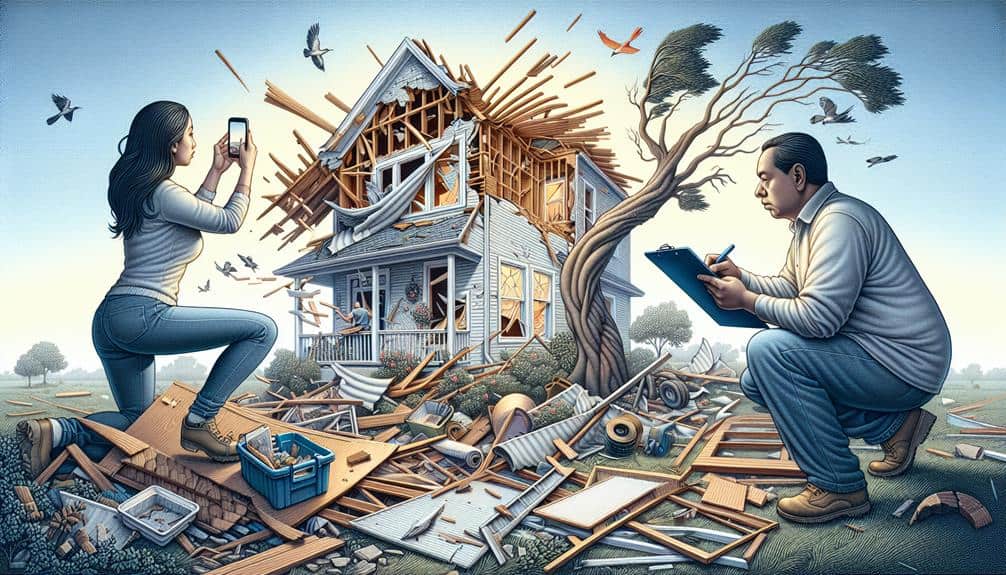We need to follow a detailed checklist to document hurricane damage effectively. First, capture high-quality photos and videos of both exterior and interior damage, using timestamps for verification. Document specific areas like water damage and destroyed furniture, and photograph identification numbers of appliances. Create an itemized report with estimated repair costs and obtain repair estimates from licensed contractors. Promptly contact local authorities for support and document interactions for streamlined insurance claims. Organizing and backing up all evidence is essential for accuracy. By focusing on these steps, we can guarantee our insurance claims process goes smoothly and learn more about effective post-hurricane recovery.
Key Points
- Take high-resolution photographs and videos of all interior and exterior hurricane damage.
- Document water damage and destroyed furniture with clear, timestamped images.
- Record serial numbers of damaged appliances and electronics for precise identification.
- Obtain repair estimates from licensed contractors to support insurance claims.
Pre-Storm Preparations
Before a hurricane hits, it's essential that we take thorough steps to protect our property and guarantee our safety. First, let's make sure we've the necessary emergency supplies. We should stock up on non-perishable food, water, batteries, flashlights, and first aid kits. These items will sustain us if we're cut off from regular services. Don't forget important documents, medications, and personal hygiene items. Having these essentials on hand is vital for maintaining our well-being during the storm.
Next, we must focus on home protection. Let's reinforce windows and doors with storm shutters or plywood. This measure can prevent flying debris from causing serious damage. We should also secure outdoor items like patio furniture, grills, and garden tools. Bringing them indoors or anchoring them firmly will minimize the risk of objects becoming projectiles.
Additionally, trimming trees and shrubs around our property can reduce the chance of branches falling and causing damage. Clear gutters and downspouts to make sure of proper drainage, preventing water from pooling around our home.
Safety Measures First
To secure our safety during a hurricane, we must prioritize clear communication and establish a reliable emergency plan. It's essential that we stay informed through trusted sources such as local authorities and weather updates.
We should also designate a safe room in our home, preferably on the ground floor and away from windows. This guarantees we've a secure place to shelter.
Key safety tips include having an emergency kit ready, which should contain essentials like water, non-perishable food, medications, and important documents. Let's make sure we've enough supplies to last at least 72 hours.
In addition, maintaining a list of emergency contacts and sharing it with all household members is vital for quick communication.
Once the storm passes, we need to be cautious when evaluating any damage to our property. Avoid downed power lines and floodwaters, which can be risky.
Taking these safety measures not only protects us but also aids in the process of filing accurate insurance claims. Entering our home safely and systematically will allow us to document the damage thoroughly without compromising our well-being.
Prioritizing safety first ensures that we can handle the aftermath of a hurricane effectively and efficiently.
Capture Visual Evidence
Let's make sure we capture clear and detailed visual evidence of the hurricane damage by taking high-resolution photographs and videos. This step is essential for substantiating our insurance claims and facilitating an accurate property assessment.
Begin by photographing the exterior of the property from various angles. Guarantee we cover the roof, walls, windows, and doors, focusing on visible damages like broken windows, missing shingles, and structural cracks.
Next, move inside and document each room. Capture images and videos of water damage, destroyed furniture, and any other internal issues. It's important to zoom in on specific areas of concern, such as mold growth or damaged electrical systems.
Don't forget to photograph serial numbers of major appliances and electronics that got damaged, as this information can be crucial for insurance claims.
We should also take wide-angle shots to provide a detailed view of the overall damage. Use timestamps if possible, to verify when the photos and videos were taken.
Keep our images and videos organized and backed up on multiple devices to guarantee we've accessible records for the property assessment. Thorough visual documentation is our ally in managing the aftermath of a hurricane effectively.
Detailed Damage Reports
After capturing extensive visual evidence, we must now compile detailed damage reports to provide a thorough account of the hurricane's impact on our property. Accurate assessments are critical for facilitating insurance claims and ensuring we receive the appropriate compensation.
Let's start by itemizing every damaged area and structure. Each entry should include a description of the damage, the estimated cost of repairs, and any necessary professional evaluations.
We'll need repair estimates from licensed contractors or professionals to solidify our claims. These estimates should be detailed, highlighting both the materials and labor costs. Attaching these professional evaluations to our reports adds credibility and helps insurance adjusters understand the extent of the damage.
It's essential to cross-reference our visual evidence with these reports. Each photo or video should match a specific item on our damage list, ensuring nothing is overlooked. This meticulous approach not only supports our insurance claims but also prepares us for any disputes or questions that may arise.
Contacting Authorities

Contacting local authorities promptly ensures we receive necessary support and resources during the recovery process. By reaching out immediately, we safeguard that our situation is documented and prioritized. This step is pivotal for streamlining insurance claims and obtaining any needed legal assistance. Local authorities can provide us with accurate information on the steps to take and the forms to fill out, making the entire process more manageable.
Additionally, contacting authorities opens up avenues for financial aid. Often, state and federal agencies offer programs specifically designed to assist communities affected by hurricanes. These programs can provide grants, low-interest loans, and other forms of financial assistance that can be instrumental in our recovery. Authorities can also connect us with community resources, such as shelters, food banks, and volunteer services, which are essential for immediate relief.
Furthermore, establishing communication with local authorities helps us stay informed about safety advisories, evacuation orders, and other significant updates. This information is essential for protecting our families and properties during and after the hurricane. By taking this proactive step, we place ourselves in a stronger position to navigate the aftermath efficiently and effectively.
Frequently Asked Questions
How Do I Store Important Documents to Prevent Water Damage?
To prevent water damage, we should use waterproof storage solutions for our essential documents. During an emergency evacuation, it's vital to keep these documents secure and easily accessible, ensuring our freedom to recover quickly and efficiently.
What Insurance Policies Cover Hurricane Damage?
A stitch in time saves nine. We need to understand coverage and policy limitations. Homeowners, renters, and flood insurance often cover hurricane damage, but specifics vary. Reviewing our policies guarantees we're prepared and not caught off guard.
How Do I Find a Reliable Contractor for Repairs?
We should start by seeking contractor recommendations and reading reviews online. After shortlisting a few, let's request repair estimates and timelines from each to compare their offerings. This guarantees we choose the most reliable contractor.
What Steps Should I Take if My Vehicle Is Damaged?
First, we've gotta document every scratch and dent like it's a million-dollar masterpiece. Then, file an insurance claim ASAP. Let's assess salvage value, arrange a rental car, and finally schedule vehicle repair with a reputable mechanic.
How Can I Protect My Electronic Devices During a Hurricane?
To protect our electronic devices during a hurricane, we should use waterproof cases and surge protectors, backup data, and keep unplugged devices off the floor. These steps help guarantee our devices stay safe and functional.


